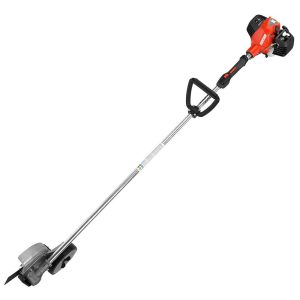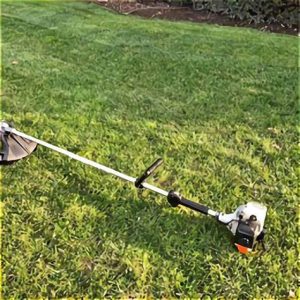The RYOBI Chainsaw is Producing Smoke (8 Causes & Solutions)
You are doing an investigation to determine the cause of the smoke coming from your chainsaw. If you look at where the smoke is coming from, you might learn a lot about what is causing it to smoke.
The increased friction between the bar and chain of a RYOBI chainsaw, an excessive amount of oil in the fuel mixture, water in the fuel system, or a clogged air filter may all cause the chainsaw to smoke.

RYOBI Chainsaw is Smoking:
- Chain that is either dull or has been improperly sharpened
- The chain is too close together.
- a bar and chain oil tank that is empty.
- Bar and chain oil of the incorrect kind
- Clogged oiler
- obstructed air filtering system
- There was an excessive amount of oil in the fuel mixture.
- There was water included in the gasoline mixture.
While diagnosing issues and making repairs on your chainsaw, use extreme care. Remove the spark plug boot after turning off the chainsaw, waiting for the engine to cool down, and then doing so.
Table of Contents
RYOBI Chainsaw Bar and Chain being used to produce smoke
While you are cutting with your RYOBI chainsaw and smoke is produced, you need to search for anything that might create higher friction between the bar and chain.
This might be the result of a poorly lubricated chain, a chain that is too stiff to travel smoothly over the bar, or a combination of the two.
Chain on a RYOBI Chainsaw that is either dull or has been incorrectly sharpened
If the chain on your chainsaw is dull, it will produce smoke and will not cut wood as well. This is due to the fact that in order to cut wood well with a dull chain or a chain that has not been sharpened appropriately, you will need to apply greater pressure.
Because of this pressure, metal-on-metal friction occurs, which generates heat and smoke.
Keep an eye out for these symptoms that the chain needs to be replaced:
- In order to produce a cut, it is necessary to exert a greater amount of pressure on the bar.
- When you chop anything, you end up with a lot of sawdust.
- Chips or other forms of chain damage.
- rakers and teeth that are worn down.
You may hone the chains on your own if you want. If you do not have any prior expertise sharpening chains, it is strongly suggested that you have a trained professional do it for you. A chain that has not been sharpened properly poses a significant risk to anybody using it.
A RYOBI Chainsaw that is Deficient in Bar and Chain Oil
If the bar and chain of your chainsaw do not get a proper quantity of oil, friction will start to build up and eventually cause the saw to break. This problem may be due to the fact that the oil tank is empty or that the oiler is clogged; either of these scenarios would be problematic.
Fill up the oil tank for the bar and chain if it is virtually out of oil or if it is entirely devoid of oil.
To assess whether or not there is sufficient oil on the bar of your chainsaw, run it at anywhere between about half and three quarters of its full power. You should look for a line of oil to flow out of the bar while you are holding it approximately one foot from the ground.
If you are not receiving an adequate amount of lubrication, you should make sure that the bar is in great shape and that the oil channel is not blocked. A new guide bar should be installed in lieu of the one that is damaged or worn out, and the oil channel should be cleaned, if required.
It is a good habit to get into of replacing the bar and chain oil each time you fill up the fuel tank on your RYOBI, and it is a good habit to get into. Getting into this pattern on a regular basis will be beneficial for you. On the other hand, if the oil that you are using in the saw is too thin, you may go through oil at a rapid rate, which would need you to check on it and maybe supply it more often. If the oil that you are using in the saw is too thick, however, you may not go through oil at all.
Using the Incorrect Kind of Oil for the Bar and Chain on a RYOBI Chainsaw
If you use an oil for your bar and chain that is too thin, you run the risk of damaging both the bar and the chain, as well as increasing the amount of friction, which may cause smoke to emanate from the bar. If the oil is too thin, it could not be able to adhere to the bar and chain, and it might instead slide off of it.
Make sure that you are using a high-quality bar and chain oil, such as one of the following lubricants manufactured by STIHL or Husqvarna:
| STIHL Woodcutter Bar & Chain Oil | Amazon | Ace Hardware |
| Husqvarna X-Guard Bar & Chain Oil | Amazon |
The RYOBI Chainsaw’s Chain Is Too Tight of a Fit
The chain will become less secure as you continue to use it, so you will need to check on it often and adjust it as necessary. But if you tighten the chain too much, it won’t be able to travel freely around the bar, which will cause an increase in the amount of friction, which will result in smoke.
Adjusting the chain tension on a RYOBI chainsaw includes the following steps:
- Take off the wire from the spark plug.
- Release the lock on the chain brake.
- Remove the bar retaining nuts that are holding on the cover that is above the chain brake and the clutch.
- Keep the tip of the bar’s nose up.
- To relax the chain, turn the tensioning screw counterclockwise, and to tighten the chain, turn the tensioning screw clockwise.
- As soon as the appropriate tension has been reached, tighten the bar holding bolts while simultaneously maintaining the bar nose-up position.
You want the chain to be able to move freely around the bar while yet sitting in a secure position around it. It is important that it not be so slack that it hangs off the guide bar.
There was visible smoke coming from the RYOBI chainsaw engine.
If your RYOBI chainsaw smokes while you are using it, you will need to investigate difficulties with the airflow, such as a clogged air filter or a problem with the fuel mixture.
Chainsaw with a Clogged Air Filter made by RYOBI
The use of a chainsaw is a very filthy occupation. Sawdust and smaller wood chips are being scattered throughout the atmosphere.
In order to prevent dirty air from entering the chainsaw’s engine, you need install an air filter. Dirt and sawdust are prevented from entering the air intake and causing wear and tear on the engine by the filter.
If you only use your chainsaw occasionally, you should change the air filter once a year and inspect it before each time you use it. If you use the saw on a regular basis, you should inspect the filter on a regular basis and replace it if it gets severely soiled or broken.
It is possible for the filter to get clogged with dirt and sawdust if it is not checked and cleaned on a regular basis to ensure that it remains in excellent condition. This would prevent an adequate amount of air from passing through the filter.
The fuel mixture is too rich, and the engine will smoke. When there is not enough air getting into the engine, it might ultimately overheat and stop working.
A RYOBI Chainsaw’s Fuel Mixture Has an Excessive Amount of Oil in It
When oil is combined with gasoline for a RYOBI chainsaw, the engine receives the lubrication it needs to continue functioning properly. Gas and oil must be combined at a ratio of 50:1 in order for RYOBI chainsaws to function properly. If you use more than this amount, it might cause the engine to start smoking.
As soon as you recognize that the smoke is originating from the incorrect fuel combination, you should drain the gasoline and reload the tank with new fuel that has the appropriate ratio of gas to oil.
In most cases, this won’t result in any long-term harm. Using gasoline that contains an excessive amount of oil, on the other hand, may produce operational issues owing to an increased accumulation of carbon in the exhaust system.
For further information on selecting the appropriate fuel for your RYOBI chainsaw, please refer to the aforementioned page.
A RYOBI Chainsaw has been diagnosed with water in the fuel system.
There is a possibility that white exhaust smoke will be produced if water is added to the fuel mixture. When water is present, there is an increased risk of corrosion in the fuel system as well as the engine.
It’s possible that you’re looking for a way to remove water from the fuel, but before you do that, you need to empty the fuel tank and refill it with a combination of fresh gasoline and oil designed for 2-cycle engines. Only then should you continue your search.
It is not worth the risk of creating damage that would need considerable repair costs or the purchase of a new chainsaw just so you can save a few bucks on water removal. The damage might end up costing far more.
It is advised that a gasoline additive be used, such as Sea Foam Motor Treatment, in order to aid in the process of removing moisture and cleansing the fuel system. Start the saw, and then let it run for a while, so that the purified fuel may work its way through the system.
Still Struggling with Issues With Your RYOBI Chainsaw?
Check out my helpful resource, Common RYOBI Chainsaw Issues, for charts that identify problems and answers to many of the frequent difficulties that owners of RYOBI chainsaws run across.
This is an excellent reference to save in your bookmarks. It addresses issues with a chainsaw not starting, getting stuck, or turning off altogether. You will also be able to obtain information about a chain that is not rotating, an engine that will only run with the choke on, as well as other topics.
In addition, you will discover connections to further material that goes into more depth on each problem.







